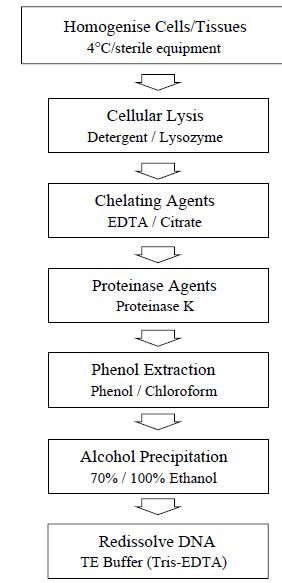


 النبات
النبات
 الحيوان
الحيوان
 الأحياء المجهرية
الأحياء المجهرية
 علم الأمراض
علم الأمراض
 التقانة الإحيائية
التقانة الإحيائية
 التقنية الحيوية المكروبية
التقنية الحيوية المكروبية
 التقنية الحياتية النانوية
التقنية الحياتية النانوية
 علم الأجنة
علم الأجنة
 الأحياء الجزيئي
الأحياء الجزيئي
 علم وظائف الأعضاء
علم وظائف الأعضاء
 الغدد
الغدد
 المضادات الحيوية
المضادات الحيوية|
Read More
Date: 21-5-2021
Date: 27-11-2015
Date: 12-12-2020
|
Isolation of DNA
The use of DNA for analysis or manipulation usually requires that it is isolated and purified to a certain extent. DNA is recovered from cells by the gentlest possible method of cell rupture to prevent the DNA from fragmenting by mechanical shearing. This is usually in the presence of EDTA which chelate the Mg2+ ions needed for enzymes that degrade DNA termed DNase. Ideally, cell walls, if present, should be digested enzymatically (e.g. lysozyme treatment of bacteria) and the cell membrane should be solubilised using detergent. If physical disruption is necessary, it should be kept to a minimum and should involve cutting or squashing of cells, rather than the use of shear forces. Cell disruption (and most subsequent steps) should be performed at 4 ºC, using glassware and solutions which have been autoclaved to destroy DNase activity (Figure 1).
After release of nucleic acids from the cells, RNA can be removed by treatment with ribonuclease (RNase) which has been heat treated to inactivate any DNase contaminants; RNase is relatively stable to heat as a result of its disulfide bonds, which ensure rapid renaturation of the molecule on cooling. The other major contaminant, protein, is removed by shaking the solution gently with water-saturated phenol or with a

Figure 1: Flow diagram of the main steps involved in the extraction of DNA.
phenol–chloroform mixture, either of which will denature proteins but not nucleic acids. Centrifugation of the emulsion formed by this mixing produces a lower, organic phase, separated from the upper, aqueous phase by an interface of denatured protein. The aqueous solution is recovered and deproteinised repeatedly, until no more material is seen at the interface. Finally, the deproteinised DNA preparation is mixed with two volumes of absolute ethanol and the DNA allowed to precipitate out of solution in a freezer. After centrifugation, the DNA pellet is redissolved in a buffer containing EDTA to inactivate any DNases present. This solution can be stored at 4 ºC for at least 1 month. DNA solutions can be stored frozen, although repeated freezing and thawing tend to damage long DNA molecules by shearing. The procedure described above is suitable for total cellular DNA. If the DNA from a specific organelle or viral particle is needed, it is best to isolate the organelle or virus before extracting its DNA, since the
recovery of a particular type of DNA from a mixture is usually rather difficult. Where a high degree of purity is required, DNA may be subjected to density gradient ultracentrifugation through caesium chloride, which is particularly useful for the preparation of plasmid DNA. It is possible to check the integrity of the DNA by agarose gel electrophoresis and determine the concentration of the DNA by using the fact that
1 absorbance unit equates to 50 mgml-1 of DNA and so
50 * A260 = concentration of DNA sample (μgml-1)
Contaminants may also be identified by scanning UV spectrophotometry from 200 to 300 nm. A ratio of 260 nm:280nm of approximately 1.8 indicates that the sample is free of protein contamination, which absorbs strongly at 280 nm.



|
|
|
|
اكتشاف تأثير صحي مزدوج لتلوث الهواء على البالغين في منتصف العمر
|
|
|
|
|
|
|
زهور برية شائعة لتر ميم الأعصاب التالفة
|
|
|
|
|
|
موكب أهالي كربلاء يستذكر شهادة الإمام الصادق (عليه السلام)
|
|
|
|
العتبة العباسية تستذكر شهادة الإمام الصادق (عليه السلام) بإقامة مجلس عزاء
|
|
|
|
أهالي كربلاء يحيون ذكرى شهادة الإمام الصادق (عليه السلام) في مدينة الكاظمية
|
|
|
|
شعبة مدارس الكفيل النسوية تعقد اجتماعًا تحضيريًّا لوضع الأسئلة الامتحانية
|